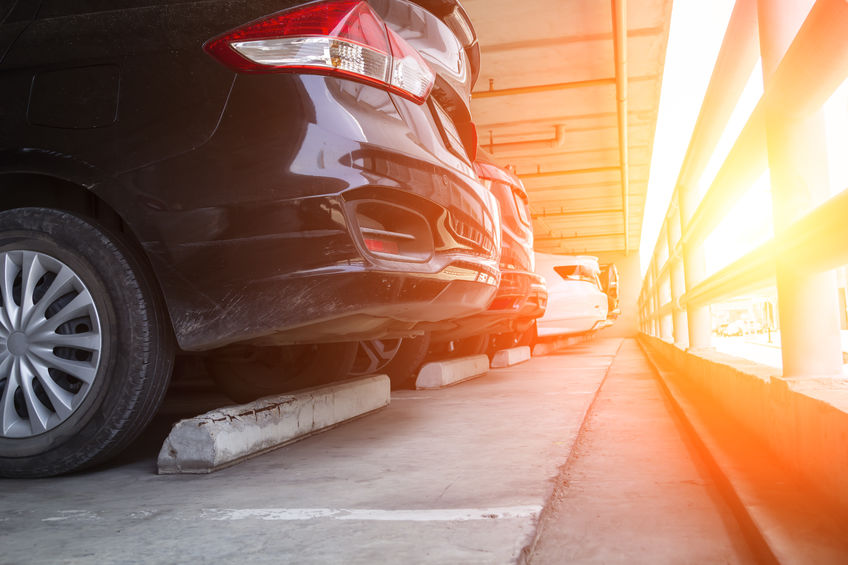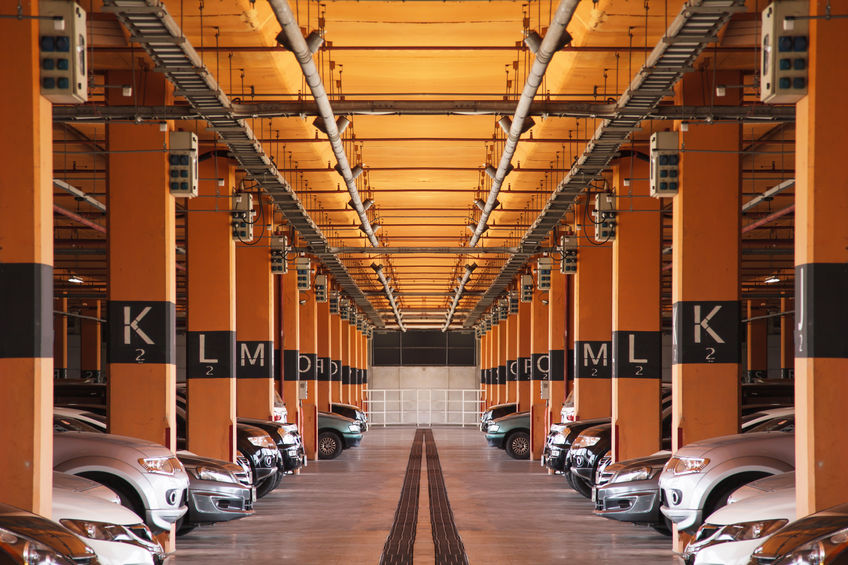Employee smart parking system is critical to going back to the office.

With private cars now preferred over mass transit, employers need to step up technology adoption to improve the safety and convenience of employee parking post-COVID. High-contact transportation options such as mass transit, ridesharing, and carpooling are posing an immediate challenge for people returning to work. Across the U.S., public transit agencies are cutting service and reducing their workforces as they face a worsening cash crunch. The often-predicted transition away from personal vehicle ownership in favor of alternative transportation has slowed, driving an increase in parking demand.
The Workforce Is Becoming Fluid, And So Is Employee Parking
When the pandemic is over, it’s projected that one in six workers will continue working from home or co-working at least two days a week, according to a recent survey by economists at Harvard Business School. Another study of hiring managers by the global freelancing platform Upwork found that one-fifth of the workforce could be entirely remote after the pandemic.
There are advantages to these arrangements for both the employee and the employer. A remote workforce can help businesses be more agile and reduce costs in competitive markets. Employees save between $2,500 and $4,000 per year by working at home half the time, and employers can save an average of $11,000 per half-time telecommuter per year.
But if companies find a remote approach doesn’t work, they could quickly change course as IBM[1] and Yahoo[2] did a few years ago. Considering the tech giants who are now proclaiming the future of working from home were, just a few months ago, outfitting their offices[3] with sushi bars, yoga rooms, and massage rooms. If companies find that remote work weakens the workforce, offices could make a comeback. It might already be happening: Just three months after its work-from-home announcement, Facebook leased[4] a massive 730,000-square-foot office in Midtown Manhattan.
We expect that while fully remote work strategies can bring some financial and strategic advantages, most employers will opt for a fluid approach. There are benefits of working in the office that teleconferencing will never fully capture remotely. Spontaneous, informal in-person conversations can only happen when you’re physically in person with other people. Zoom will never replace random brainstorming, stand up meetings, a quick lunch, or drinks after work.
Case in point, Microsoft’s pre-pandemic campus renovation and expansion are on track even as it endorses remote work. In October, Microsoft announced[5] a “hybrid model” for most roles and considers it standard to work from home at least part of the time. A Microsoft spokeswoman said the company remains “committed to our investment in providing employees an exceptional place to work and create greater collaboration and community.” When completed, Microsoft’s campus will include a 2-acre plaza that can accommodate up to 12,000 people for meetings and events, sports fields, and an underground “smart” parking facility with a pedestrian and cyclist bridge spanning Highway 520 to connect Microsoft’s east and west campuses.
The New Fluid Workforce Needs Opt-In Workspace and a Smart Parking System for Employees
A fluid workforce balances employee concentrative remote work with collaborative teamwork in the office. Time at the office will help overcome social isolation, decreased collaboration, and less visibility to co-workers and management. With a fluid approach, staff parking becomes a significant consideration.
Before COVID, workplace parking was considered one of the most appreciated benefits for employment.
Today, more than ever, corporate perceptions are shifting from office real estate viewed as a static expense to it being a strategic driver of transformation and employee performance.
How To Solve Parking Issues At Work
Post pandemic, there is a sustained, long-term employee demand for purposefully designed office space and parking for employees, with safety and well-being at its core.
Company parking for employees has long been considered one of the most important benefits of employment, and even before COVID, it was a common problem. At one Tesla Factory, for example, there are not enough parking spaces at work with 6,000 employees competing for 4,500 parking spots[6] creating “parking lot wars” and even worse. Palo Alto’s deputy fire chief, Catherine Capriles, calls Tesla’s parking situation a “nightmare.” The Palo Alto fire department has responded to at least three medical emergencies at the headquarters in the past year and ran into trouble when parked vehicles blocked the fire engine from turning or backing out, Ms. Capriles said.
“Parking is, like, one of my biggest nightmares–like, where do we park everyone?”
Elon Musk
Post pandemic, even with fewer office employees, more will be driving private vehicles, and employee parking at work will become more critical than ever before. Smart parking systems are crucial to alleviate traffic and make parking more efficient and better managed.

Smart parking eases the process of bringing employees back to the office
Smart Parking is an integrated network of devices and technology that interface seamlessly with an employee’s smartphone. For example, a smart employee parking lot shows available spaces through an app, allows employees to reserve parking ahead of time, enables quick and straightforward entry to employees with reservations, and allows parking lot exit through a mobile device.
Smart parking tracks and manages volume and enables appropriate physical distancing.
Employee parking lots with smart parking reservation systems make parking stress-free. Employees get real-time updates about available parking on their mobile phones, make reservations, plan their commute, and schedule onsite office visits accordingly. Employers can make better-informed space usage decisions, optimize costs, and offer a better parking experience for employees. Parking utilization is further improved by incorporating reservations for visitors and contractors.
With contactless parking, employees enter a facility without exchanging tickets with a staff member, don’t wait in long queues for entry, and use a smartphone for reservations. In such a fully automated system, employees neither come in close contact with parking staff nor with each other as they quickly move through different touchpoints in a facility. This also benefits employee parking lot operators who can remotely monitor and analyze parking data without physically stepping into a facility.
When Employees Aren’t Working, Parking Lots Become Off-Hour Revenue Streams
Before COVID, there was an abundant surplus of parking spaces in the United States. In the U.S., there are 2 billion spaces for roughly 250 million cars, with most of this real estate sitting vacant all the time[7]. But during a pandemic, parking lots have become the hottest place in town.
Agile design, technology integration, flexible lease terms, and hospitality services transform parking lots into community hubs that connect people to pop-up businesses and services.
Property managers can repurpose space with real-time occupancy data by hosting events onsite and providing event parking for new off-hour revenue streams. Markets, Food Festivals, Pop Up Kitchens, and Retail are booming in parking lots. With outdoor space at a premium, garages open their parking lots to vendors for open-air stores and other events. Some use lots for public-service functions like job fairs, voting stations, and drive-through Covid-19 testing. Others have become gathering spots for trivia or bingo games where participants play from their cars. Events like this create revenue by occupying unused weekend or evening parking spaces providing vendors and visitors paid parking.
Dynamic parking turns free employee parking lots into revenue-generating assets during non-working hours, especially as more commuters opt for private transportation.
When demand is low, rates reduce to become more competitive, and during peak hours, rates increase to capture revenue opportunities and control occupancy. Parking reservations promote parking availability and drive repeat and predictive revenue.
How Does A Smart Parking System Work?
Smart Parking systems use integrated sensors and devices that seamlessly track all activity within a parking garage. The system connects to the cloud, allowing the system to display valuable information to the driver. Smart Parking facilities also connect to the cloud, allowing employees to view current availability within the parking garage and make reservations from their smartphone or computer. By keeping track of these reservations and cars currently in the facility, the system can automatically detect parking at full capacity, limiting access to only vehicles with a reservation.
Nwave Makes Your Parking Garage Pre And Post-COVID Ready
Nwave, a smart parking technology company, is the developer of a revolutionary wireless parking management system that helps parking asset operators streamline their processes. Nwave’s sensors generate accurate data per-spot occupancy in real-time and transmit it to Nwave’s cloud, making the analyzed information available to drivers via mobile navigation apps and digital signage, guiding them in real-time to the nearest open spot.

